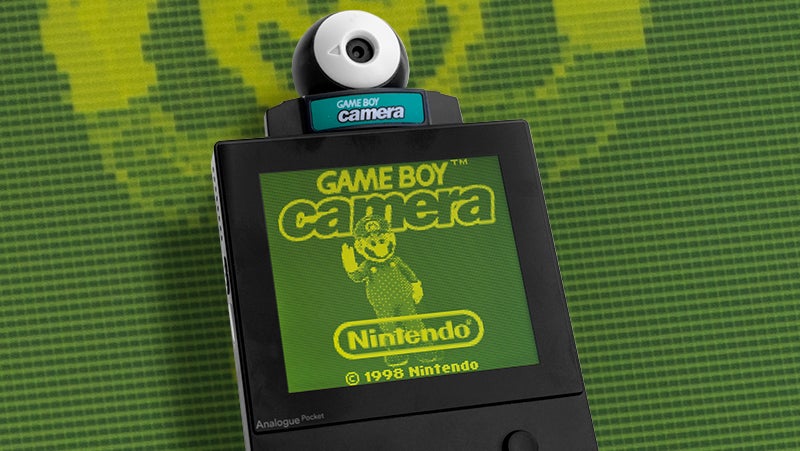We love the Analogue Pocket, but the retro gaming handheld didn’t launch with its entire feature set. Instead, features like a wikipedia-esque library mode, more comprehensive save states, and the easy offloading of Game Boy Camera pictures were pushed off for an eventual 1.1 release. Well, now that release is available in beta, and it comes with additional features including the openFPGA developer program, which should allow devs to enable the Pocket to mimic many more systems than it can now.
A “Scholarly Level” Gaming Database
‘Library’ is perhaps Analogue OS’ most ambitious new feature. This is being positioned as a “reference level database” of video games that will take you through gaming’s history by system, game, region, developer, publisher, and even revision. Analogue’s promised that it’s really going for breadth here, and that Library will eventually catalogue more games than just what the Pocket can play.
“We’ve been building a scholarly level library/database of original media for a long time now,” Analogue founder Christopher Taber told me over email. “Library was created for Pocket and future Analogue products. It will extend beyond the systems that can be played on Pocket – we are going to catalogue everything possible.”
“Everything” is a lot… you only need to visit itch.io, or even some of the less popular sections of the Steam store, to see that gaming is a truly wide medium. It will be some time before we just how big Library becomes, since it’s not going to launch in a final state. For now, Library will work by showing you information about an authentic game cartridge when you insert it into the Pocket, including any relevant user generated assets you might have installed on your system.
openFPGA and 3rd Party Cores
openFPGA, on the other hand, is how v1.1 is most radically expanding what the Analogue Pocket can do. It’s a developer program that’s already been given to “several 3rd party developers” in an early access format, and will allow them to make their own “cores” for the Analogue Pocket. A new core represents a new console for the Pocket’s FPGA tech to try to mimic; that means in the future, we might get a lot more systems on the device than the Game Boy, Game Boy Colour, Game Boy Advance, Game Gear, Neo Geo Pocket, and Atari Lynx compatibility it has right now.
To start openFPGA off, 3rd party developer Spacemen3 has ported the PDP-1 to the Pocket. Don’t blame yourself if you don’t know what that is: It was one of those giant, person-sized computers from the late 1950s. What makes it notable is that it also happened to be on the MIT campus at the same time as Steve Russel, who alongside his friends in the Tech Model Railroad Club, used it to develop Spacewar!, a simple piece of software that is widely recognised as the first digital video game, preceding Pong by 10 years.
The PDP-1: Spacewar! core was made available to press as part of our v1.1 preview, but Spacemen3 will be distributing it to the public on its own.
Better Save States
One of the best features software emulators usually have over hardware emulators like Analogue’s is save states, or the ability to quickly save where you are in a game separate from that game’s internal save system, and then load it whenever you want. It’s a great feature for pick-up-and-play sessions, or to avoid getting sent back to the start of a particularly tough level. The Analogue Pocket introduced save states in an official capacity for the first time on an Analogue product at launch, but only in a reduced beta form that could save just one state at a time per game, and with no graphical interface.
In contrast, the v1.1 memories function promises “128 memory slots usable by Game Boy, Game Boy Colour, Game Boy Advance, & Game Gear.” You’ll be able to access these memories in list format with their dates and times of creation displayed prominently, but the feature promises to expand to include screenshots on each save state in the future.

Easily Transfer Game Boy Camera Photos
Analogue Pocket v1.1 also promises to up the device’s Game Boy Camera compatibility, although this’ll be in the final update rather than the beta. The pre-smartphone digital camera, which hit markets in 1998, was never considered great, even when it came out. Its 128 x 128-pixel CMOS sensor just couldn’t capture enough detail to make out most subjects, and the out-of-the-box limitation to black-and-white photos didn’t help. But that hasn’t stopped the retro gaming community from embracing the device. Hackers have found ways to connect it to modern printers and wirelessly transfer images to a smartphone. Now the v1.1 update will let you just slap your Game Boy Camera photos onto a microSD card, and put that into another device to retrieve them. We’re excited to toy with this and share all our 0.001434 megapixel masterpieces with you later this fall.
When’s Analogue Pocket v1.1 leaving Beta?
All of this sounds super exciting, though features like Library and Memories will clearly need more support down the line to reach their full potential. Analogue founder Christopher Taber provided a software development schedule to Gizmodo that said we can expect the v1.1 to be near complete around September. We’ll keep you up to date as we learn more.
